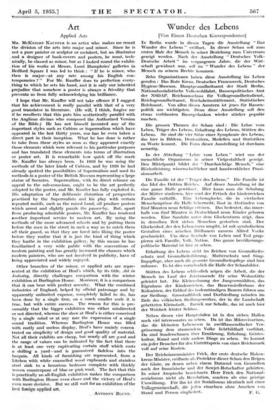Art
Applied Arts MR. McKramer KAUFFER is an artist who makes me resent . the division of the arts into major and minor. Since he is . not a pure painter or sculptor or architect, but an illustrator and a designer of book-covers and posters, he must, tech- nicany, be classed as minor, but as I looked round the exhibi- , tion of his works at Messrs. Lund Humphries' galleries in . Bedford Square I was led to think : "If he is minor, who then is major—at any rate among his English con- temporaries ? " For Mr. Kauffer does to perfection every- , thing to which he sets his hand, and it is only our inherited - prejudice that somehow a poster is always a frivolity that , prevents us from fully acknowledging his brilliance.
I hope that Mr. Kauffer will not take offence if I suggest that his achievement is really parallel with that of a very good translator in literature. (He will, I think, forgive me if he recollects that this puts him aesthetically parallel with the Anglican divines who composed the Authorized Version
• .a the Bible.) He has not himself invented any of the important styles such as Cubism or Superrealism which have appeared in the last thirty years, nor ,has he even taken a direct part -in their inception. What he has done is rather to take from these styles as soon as they appeared exactly those elements which were relevant to his particular purposes and has translated these elements into terms of illustration or poster art. It is remarkable how quick off the mark Mr. Kauffer has always been. In 1919 he was using the methods of the later kinds of Cubism, and by 1926 he had already spotted the possibilities of Superrealism and used its methods in a poster of the British Museum representing a large statue of Socrates. Superrealism, with its direct reliance on appeal to the sub-conscious, ought to be the art perfectly adapted to the poster, and Mr. Kanner has fully exploited it. His adaptation of the deliberate distortion of perspective practised by the Superrealists and his play with certain repeated motifs, such as the raised hand, all produce posters which arrest and slightly puzzle the passer-by. But, apart from producing admirable posters, Mr, Kauffer has rendered another important service to modern art. By using the methods of the more advanced schools and by putting them before the men in the street in such a way as to catch them off their guard, so that they are lured into liking the poster before they realize that it is just the kind of thing which they loathe in the exhibition gallery, by this means he has familiarized a very wide public with the conventions of modern painting and has greatly increased the chances which modern painters, who are not involved in publicity, have of being appreciated and widely enjoyed.
Other branches of the minor, or applied arts are repre- sented at the exhibition at Heal's which, by its title, Art in Industry, directly challenges comparison with the winter exhibition at Burlington House. Moreover, it is a comparison that it can bear with perfect serenity. What the combined industries of England, helped by official patronage and by apparently unlimited expense, completely failed to do, has been done by a single firm, on a much smaller scale it is true, but with entire success. The reason for this is pre- sumably that the bigger exhibition was either misdirected or not directed, whereas the show at Heal's is either conceived by a single mind or at any rate the expression of a single sound tradition. Whereas Burlington House was filled with costly and useless display, Heal's have mainly concen trated on simplicity of design and good quality of material. Not all their exhibits are cheap, but nearly all are good and the range of values can be indicated by the fact that there is at least one very captivating curtain stuff which costs a shilling a yard—and is guaranteed fadeless into the bargain. All kinds of furnishing are represented, from a kitchen with white enamelled wood cupboards and stainless steel sink to a luxurious bedroom complete with thickly woven counterpane of blue or pink wool. The fact that this is practically an all-English exhibition makes the comparison with Burlington House even closer and the victory of Heal's even more decisive. But we still wait for an exhibition of the best foreign applied art.
ANTHONY BLIP-1T.










































 Previous page
Previous page